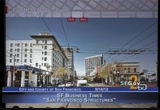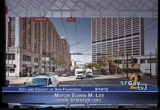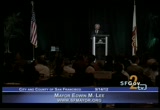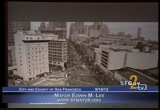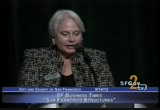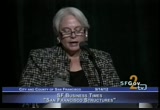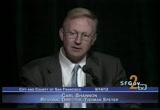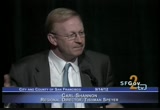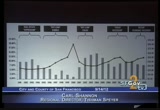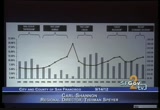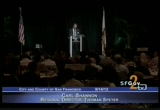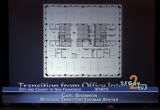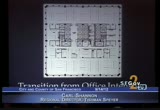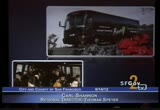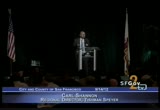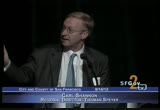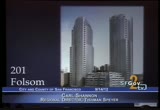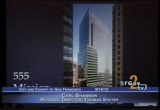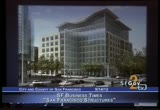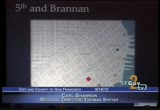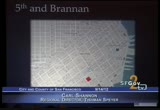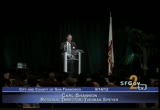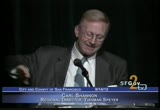tv [untitled] September 28, 2012 10:30pm-11:00pm PDT
10:30 pm
in june, dolby purchased the old state compensation fund building for their new headquarters and space, which can accommodate a thousand employees. they are underconstruction now. across the street from dolby, the large and long inactive federal building on the u.n. plaza is undergoing renovation and will be opened next year, bringing 600 jobs to the area. proving that central market can be a place to live, to work and to play. i recently helped to break ground for a new housing development at 55 9th street, literally right behind the dolby building. avalon bay will construct 273 units providing needed housing for people who want to live in a vibrant and active neighborhood. this part of central market is also seeing many of the existing small businesses flourish. jeannie kim of sam's diners is
10:31 pm
here with us today and she has been serving home cooking food on central market for over 30 years. the buzz in the neighborhood inspired jeannie to give her restaurant a facelift on our own dime and introduced newcomers to the neighborhood staple. jeannie is here today and stand up, jeannie. i want to thank you and everybody take a trip to sam's diner on markets street. [ applause ] and down the street from sam's is phillip's marvelous coffee shop. it's a mecca for coffee aficionados and i know it was opened in anticipation of the twitter neighborhood and you will see tables full of twitter employees. thank you phillip for your investment and your confidence in our city. so i think you have heard, all of you, that twitter moved into
10:32 pm
the neighborhood. well, they moved in to the market square building this summer. if you ever get a chance, get to the rooftop. i don't know what connections people might have with twitter, just tell them you are a twitter and you can tweet, but i have to get to the rooftop, because if you get up there you will see an iconic view of the city's dome a wonderful city. they are being joined by others and has an ambitious team for the ground floor that includes retail, restaurants and even a grocery store to serve the neighborhood. they are already working on the building behind it on stevenson alley. and across 10th street, crescent heights the big tower is going up as we speak, 750 units of housing for folks who want to move in, beginning late
10:33 pm
2013. the emerald fund is also adding 399 units with their project on 100 van ness, transforming what used to be the triple a office building through the interior and facade roimprovements into housing. ladies and gentlemen, the people sitting with me today and many of you in the room believe as i do that the best days of central market are yet to come. this is the story of san francisco, a city of innovators, entrepreneurs, risk-takers and doing who look together and work together to make it happen. this is what san francisco is about. this is why i don't get any rest. this is why you don't want get any rest. we want to continue making san francisco the best city in the world. thank you very much for working with all of us. [ applause ]
10:34 pm
>> thank you mayor lee. what a great tour. i think everybody who hasn't, get out and do this on foot and you can really see the dramatic difference. so now let's take a look at the office market and maybe a little at residential and there is actually an office building underway. tishman spire is the person who will tell us about. so quickly carl is responsible for the portfolio in the san francisco bay area, which is really the whole garet greater bay area and was closely involved in two signature projects over seeing the development of the
10:35 pm
infinity, 650-unit condominium project and 555 mission, which is the 55,000 square feet building already bottle. and now tishman spire has started construction on the fourth and final building, and the company has two more projects lined up. another 650 units of residential towers at 201 folsom and other office tower at 222 2nd street. so to give us his perspective on the market and the future, please welcome carl shannon. [ applause ] >> good morning. thank you mary. what an amazing opportunity to be here.
10:36 pm
today i live here with my family and raising two young daughters in san francisco.uf for those who don't know me, i am not a religious person. but i think we should all take a moment and say a prayer of thanks for the environment we live in. for all of us who touch bay area real estate, it's really incredible how quickly things have changed. if you go back two, two and a half years and think about what the environment was in the middle of 2010, we were in a
10:37 pm
terrible environment. values were down significantly. we couldn't lease space it save ourselves and we felt it would be a long, long slug to come out of the hole we were in. here we are, barely two years later, in one of the strongest office markets in the country. the growth for is overwhelming a shrinking of real estate needs and we're not seeing that kind of growth in new york or washington. it's very select markets that we're seeing the kind of growth that you are seeing in san francisco. so we all should be grateful that we work in this very unique and interesting
10:38 pm
environment. i am also grateful to jerry and rob speyer for driving this company that can take on and capitalize projects. there are few companies able to do this. i feel very lucky to be part of such a strong and wonderful team and to work with my colleagues here in san francisco. i have to talk first today about what we see going on and then i'm going to talk a little bit about how we at tishman speyer want to capitalize on that. i'm going to start at the risk of boring everyone with a couple of charts. the first chart shows the average sales prices for office buildings in blue. it shows the average replacement costs in green and the line is the cap rates for office product in san francisco.
10:39 pm
and there are a couple of things that i think are worth pointing out in this chart. first, that while values have increased, they still fall short of the peaks that we saw in 2007. also while replacement costs have been fairly steady here in the last several years, if you look back historically, there has been a stair-stepping historically over time of replacement costs. and i believe that we're about to enter an environment where both construction costs and land costs will push replacement costs up again in san francisco. also while cap rates have come down significantly since 2010, they are still well above where they were in the 2006-2007 environment. and keep in mind that the treasury market is significantly tighter today.
10:40 pm
bond rates have tighter today. and so those yields, while they have come down significantly, still offer attractive returns over fixed income securities. the second chart shows rents and vacancy showing rents in nominal dollars. i think one of the most important things is that while we have seen a run up in rents that rents have basically come back to the 2007 levels, but well short of the rents that we saw back in 2000-2001. this is in nominal dollars and if you remember, can we go backwards? no, we can't go backwards. can we go backwards? i want to
10:41 pm
go backwards. the replacement costs back in the 2001-2000 timeframe is much lower than what it is today. so in that environment, when replacement costs were lower, we were able to support these higher rents. today, with these higher replacement costs, i think there is significant room for rents to run. two important things that i think are going on sort of the soft side of real estate. one is that the electronic storage documents means that office space is much smaller. also in this generation, the amount of office space needed per employee has declined as densities increase. so gone are the file cabinets, gone are the wall libraries, but so too are gone are the private offices. today all of the buzzwords are
10:42 pm
about benching and collaborative space. as an example, we were able to draw major accounting consultant firm into 555 mission. that tenant went from 290,000 square feet to 190,000 square feet without laying anybody off. so they are able to shrink their space by a third, without losing any jobs. part of that is technology. part of that is the efficiency of the building. part of is it is hoteling, but if you think about their traditional tenants and all the tenants in america get smaller by 30% without firing anybody, we wouldn't have to build any office buildinged for a long period of time. so what is remarkable about what is going on in the bay area, we have been able to absorb that
10:43 pm
contraction in the tenants, which jk put on the front page today and managed to overwhelm that with growth in technology and technology-related tenants, which is why what is going on in the bay area today is so extraordinary relative to what is going on in the rest of commercial real estate across the country. when we look at this, in practical terms, here is a prototypically way for a tenant in an office building. this layout allows people to reach a ratio of 110 square feet per person or over nine people per thousand square feet. this density, i think, is very important. it means a couple of things. first, it means that san francisco and other transit-rich locations will win
10:44 pm
over suburban greenfield sites, where projects are typically parked at three or 3.3 per thousand. because if you build this kind of density on market street, or you build it in san francisco, your employees can get there by bike, by muni, by bart. if you build this in north bay shore, you can't get your employees there to build out this kind of density. we're very much seeing this on the peninsula, where the office buildings that are located close to the caltrain are really distancing themselves from the other buildings on the peninsula in the northern part of the valley that aren't near the train. because that access to transit is so incredibly important. the other thing that i would point out is that while you are putting these kind of densities into this space, this is not back off this space for bank of
10:45 pm
america circa 1975, where these people are making $15,000, $20,000 a year. most of these jobs are high-paying engineering jobs. so you are putting a lot of people with high payroll into a relatively limited amount of space. and i think that that means that rent is less important. it's not irrelevant. but it's less important to these people and the willingness to pay rent to be in the right location and be able to retract and retain talent, being in the right location is critical. how much you pay in rent is less critical. and i think that sets the foundation where rates can go up . the key is having the right
10:46 pm
work environment, retaining people, the key is being in a cool environment. thankfully for all of us, particularly for the people sitting at table 3, san francisco is cool. it's diverse. it's progressive. it's dynamic. it's hip. young, bright people want to live here. i'm going to date myself a little bit, but when i graduated from college, you know, the logic was that you went and found the best job that you possibly could, and if that job took you to cleveland or took you to newark, new jersey, you went and took that job. today if you graduate from college, you move to someplace that is cool and fun, and then you look to find the best job that you can. and that is extraordinarily
10:47 pm
important for san francisco. the fact that this is someplace that people want to live coming out of school, means that the employees are moving here. this is not something that is lost on traditional silicon valley. silicon valley has figured out that people want to live in san francisco, and the solution, the short-term solution is the buss that we all see, that now start in marin county and pick people up at the presidio and into the city as they go down to oracle and google and adobe, and apple. all of these companies are running these buses to bring people that they want to hire
10:48 pm
and they want to retain down to their corporate headquarters in silicon valley. it's a tremendous change and i would postulate if you think about this for a moment, it's essentially like the suburban flight of the 1960's turned on its head. when you think back about what was going on in cities in suburbia in the 1950's, '60's and 70's, people didn't want to live in the cities and people wanted to go out to the suburbs for good school districts and a good quality of life. today that is turned on its head. people want to be in the cities. they want the activity. they want to be in the dynamic environment. what you saw in the suburban flight of the 1960's and 1970's was that after people moved out to the suburbs, so, too, did the companies move out to the suburbs. and i think what you are going
10:49 pm
to see is increasing pressure, if this is a battle between the employees and the employer about whether given that the employees want to live in san francisco and the employers want to be out where their corporate campuses are. if that is an arm wrestling match, i'm going to bet on the employee, because i think at the end of the day, if you run a major company, and your employee can quit and get off this bus and stop commuting an hour and a half each way each day and skateboard, ride bart, ride muni to work and be at sales force or twitter in 10 or 15 minutes as opposed to riding on the bus for an hour and a half, i think the companies will be forced to increase their footprints in san francisco and i think you will see what is going on
10:50 pm
demographically as being tremendously important to san francisco in the years ahead. so as we look at this from tishman speyer's perspective, how do we capitalize on this? what do we do? the first thing we do is build housing. mayor brown newsom and lee have done a great job in getting more housing in san francisco and we at tishman speyer have tried to capitalize on this. is this our first high-rise residential project in the project. it's a 650-unit project, the infinity, which was delivered in 2008-2009, arguably the worst timing we could have thought up for building a major condominium project. yet that project is completely sold out. it was a strong financial success and there are a thousand people living in these buildings today who call san francisco home. this is a thriving community
10:51 pm
south of market. given the recovery, we hope to repeat this starting next year with our project across the street at 201 folsom. this is another 650-670 units to be built on the south side of folsom between main and beale. we're also proud of the fact that through our commitment to the board of supervisors, that for both of these projects, we said yes, we will make a commitment not only to helping fund affordable housing, but to actually getting it built. and together with evans and union property capital we built unitss at 900 gilman down in the bayview and 165 units at 88 7 emstreet at the square and to build that kind of affordable housing in san francisco with market rate housing and live up to our obligation to the board is something that we're very proud
10:52 pm
of. we hope to replicate that again at 1400 mission together with tndc as an off-site project linked to 201 we also build offices in san francisco. here the city has done less well in bringing things through the permitting process. in part because of prop m and in part because of ceqa and in part because the higher fees have raised the bar and today there are very few actually entitled projects and we at tishman speyer have tried to capitalize on the locations here. this is a site we entitled in 2001. the dot com bust made us wait until we began construction and this is the only sizeable new building built from the last cycle. when we began in 2006, we felt we were early. midway through construction in
10:53 pm
2007, we were feeling pretty smart, but we delivered this within weeks of lehman's bankruptcy in the fall of 2008, again into one of toughest markets you could envision for building half a million square foot speculative officer building, but it's a lesson in building great products and even in terrible markets you will do okay. we were able to sell it for just over $800 a square foot, which i think is a strong sign of the recovery in san francisco. also allowed to us make an $11 million contribution to the general fund for transfer taxes. [ [ laughter ] [ applause ]
10:54 pm
looking forward this is foundry square 3. this is the last of the four buildings at the corner of1st and howard. this is a project that was originally envisioned by studios and william wilson and associates. we were extraordinarily lucky to pick up this last corner to complete this project earlier this year. we began construction in july. construction is going extraordinarily smoothly. we expect to be done by the end of next year, but no, despite the rumors in the marketplace, we don't have a signed lease. but we are blessed with a tremendous amount of interest and activity in this building. we hope to follow it next year with 222 2nd. this is just a block to the west at the corner of 2nd and howard. it's a 450,000 square foot building. both of these buildings from a location standpoint and a product standpoint we're trying to carefully position as the
10:55 pm
crossroads of the traditional cbdg, but very much in the south of market tech-friendly locations in terms of the size of the floor plans and the way the lobbis are designed to make these great technology locations. looking forward we have tied up the site at 5th and brandon as part of the capitol corridor project and what until recently has been a neighborhood that nobody thought of for office. but given the access to the train, given the access to the freeways, and given the sort of geographic dispersion that has been part of this tech renaissance, we feel this is an extraordinarily good site for a
10:56 pm
corporate campus in san francisco in the years ahead. the footprint is expanding and we feel this is where the growth in san francisco is going, not necessarily into the very tall towers that are being talked about in the heart of the transit center district. that from our perspective are difficult to pull off, given the size of those towers and the height of those towers. one last thing i want to touch on, given that thatis cycle is technology-driven i get asked three or four times a day, aren't we just falling into the same bubble that we did at that time? and clearly technology and real estate are cyclical and we will go through cycles.
10:57 pm
having been there in sill cron valley in 2000 and sitting here today, there are a couple of things that i see as being significant. first and foremost, the tech tenants that we're dealing with are move stronger financially than the tenants that we saw in 2000. in 2000, the name of the game for these technology tenants was to go public and everybody was looking for an ipo as their exit. and given the focus on the ipo, they were all focused on market share, first and foremost, and almost everything else was irrelevant. today while the ipo market opens and closes, most of these companies are being managed as much to be acquired as they are to go public. and that means that there is a
10:58 pm
focus on the liabilities of the company, that there wasn't in '99 and 2000 and also the amount of capital is much more concentrated in a number of key vc firms and being doled out in smaller pieces. in late '90-2000, it spread through the vc community that wait a minute, everybody is going to run out of space. and the signal got sent to all of these boards that have you go to control real estate to be able to grow and we saw tenants taking three, four, five and in some cases eight or nine times their current foot print it in their new leasing requirements. i knew we were in trouble in 2000 when one of the tenants turned to me when we said why do you need all of this space? and they said that it was part
10:59 pm
of their business plan that they were going to lease more space than they needed, but because the market was increasing so quickly, they were going to make money on subleasing the space i had leased to them to others. we don't see anything like that going on today. the space that is being taken is much more logical. the m&a activity going on in technology keeps the growth in check. we continue to stair-step along. it's not the sort of constant runup we saw in the earlier cycle and for those of you who focus on san francisco, san francisco is participating in this recovery in a way that it never did before in terms of the number of people living here and the kind of jobs that are being created here. we spent a lot of time talking about the risks of what could happen. what could happen in euro
99 Views
IN COLLECTIONS
SFGTV2: San Francisco Government Television Television Archive
Television Archive  Television Archive News Search Service
Television Archive News Search Service 
Uploaded by TV Archive on

 Live Music Archive
Live Music Archive Librivox Free Audio
Librivox Free Audio Metropolitan Museum
Metropolitan Museum Cleveland Museum of Art
Cleveland Museum of Art Internet Arcade
Internet Arcade Console Living Room
Console Living Room Books to Borrow
Books to Borrow Open Library
Open Library TV News
TV News Understanding 9/11
Understanding 9/11